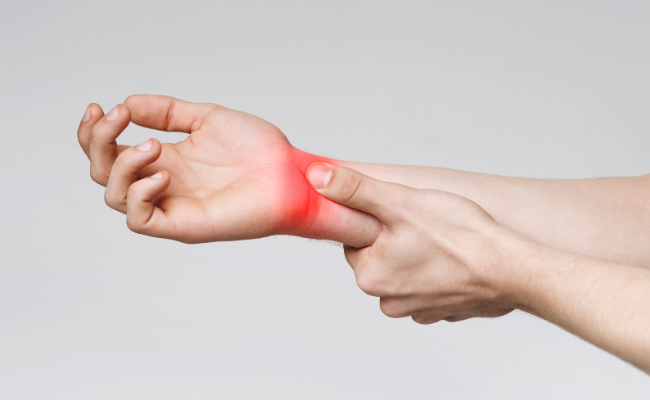How to Treat Carpal Tunnel Syndrome?
- January 31, 2024
- No Comments

What is Carpal Tunnel Syndrome?
Carpal Tunnel Syndrome (CTS) is a prevalent condition arising when the median nerve, extending from the forearm into the palm, undergoes compression at the wrist. Situated at the base of the hand, the carpal tunnel, a confined passage of ligament and bones, accommodates the median nerve and tendons. Inflammation or compression of these structures leads to symptoms such as pain, numbness, tingling, and weakness in the hand and fingers.
Treating Carpal Tunnel Syndrome involves understanding its origins, recognizing symptoms, and implementing effective treatment strategies. This medical condition affects the hand and wrist, involving a narrow passageway on the palm side of the wrist, encompassed by bones and ligaments. Within this tunnel, the median nerve, responsible for sensation in the palm side of the thumb and fingers (excluding the little finger), traverses alongside tendons.
Why is Carpal Tunnel Syndrome a Concern?
The compression of the median nerve within the carpal tunnel can lead to a range of symptoms, making Carpal Tunnel Syndrome a significant concern.
- Pain and Discomfort: Individuals with CTS often experience pain, particularly aching or burning sensations in the hand and wrist.
- Numbness and Tingling: The compression of the median nerve can cause numbness and tingling, commonly felt in the thumb, index finger, middle finger, and part of the ring finger.
- Weakness: Grip strength may weaken, making it challenging to hold objects or perform manual tasks.
- Sleep Disturbances: Symptoms can worsen at night, leading to disrupted sleep patterns.
Understanding the impact of these symptoms emphasizes the importance of addressing Carpal Tunnel Syndrome promptly.
How to Identify Carpal Tunnel Syndrome?
Identifying Carpal Tunnel Syndrome involves recognizing specific signs and symptoms
- Hand Numbness: Persistent numbness or tingling, especially in the thumb and first two fingers.
- Nighttime Symptoms: Symptoms may worsen during the night, leading to sleep disturbances.
- Weakness: Reduced strength in the hand, making it challenging to grasp or hold objects.
- Pain Radiating: Pain or discomfort may radiate from the wrist up the arm.
- Tinel's Sign: Tapping over the median nerve at the wrist may produce tingling or shock-like sensations.
Treatment Solutions for Carpal Tunnel Syndrome:
Addressing Carpal Tunnel Syndrome involves a combination of conservative measures and, in some cases, more invasive interventions. Here are various treatment solutions:
- Rest and Immobilization: Resting the affected hand and avoiding activities that worsen symptoms. Reducing strain on the wrist helps alleviate inflammation and promotes healing. Wearing a wrist splint to keep the wrist in a neutral position, particularly at night, can be beneficial.
- Medications: Nonsteroidal anti-inflammatory drugs (NSAIDs) or corticosteroids. To alleviate pain and reduce inflammation. Oral medications or, in some cases, corticosteroid injections into the carpal tunnel.
- Physical Therapy: Exercises to improve strength and flexibility. Strengthening muscles and maintaining flexibility can help reduce symptoms. Working with a physical therapist to learn and perform specific exercises.
- Activity Modification: Adjusting activities that may contribute to symptoms. Avoiding repetitive hand movements or maintaining proper ergonomics can prevent worsening of symptoms. Modifying workstations, using ergonomic tools, and taking breaks during repetitive tasks.
- Surgery (Carpal Tunnel Release): Surgical intervention to release pressure on the median nerve. When conservative measures fail to provide relief or in severe cases. A surgeon cuts the ligament pressing on the median nerve to create more space within the carpal tunnel.
Benefits of Timely Treatment:
- Symptom Relief: Reduction in pain, numbness, and tingling. Timely intervention addresses the underlying causes, providing relief from discomfort.
- Prevention of Complications: Avoiding complications such as muscle atrophy or permanent nerve damage. Early treatment prevents the progression of the condition to more severe stages.
- Improved Functionality: Restoration of hand and wrist function. Effective treatment enhances the ability to perform daily activities and tasks.
- Enhanced Quality of Life: Improved overall well-being. Relief from symptoms contributes to a better quality of life, both physically and mentally.
- Reduced Need for Invasive Procedures: Minimized reliance on surgical interventions. Timely and effective non-invasive treatments can eliminate the need for more aggressive measures
Comments (0)